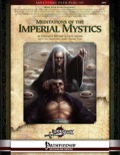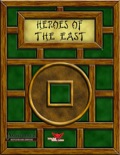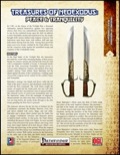Sign in to create or edit a product review. Heroes of the East is a 18 page pdf that opens with a nearly blank first page, which is followed by a page of credits before moving to the 16 pages of content. The bulk of the content includes a new class and two archetypes. I will mention each briefly below. Making up 4 and a half two column pages, the Tao class’s thematic description fits a monastic character that mechanically aligns with the bard as far as flexibility is concerned. Although the class involves some bookkeeping beyond conventional classes, it is a great addition. Beyond minor errors, see discussion, this is four star material. Personally, I'd give it five stars. The Tao is a moderately capable unarmed combatant that is limited to non-lethal damage in most situations. Although the Tao's unarmed damage does scale, it's spontaneous casting ability (think Qinggong Monk style spell use) really seems to be what makes the class viable. Although some flavor and description is included for the class along with a gray scale illustration (oddly posed, but well done otherwise), much of the content is devoted to mechanics. A full spell list and Tao Scale (at the end of the pdf) are included for use with the class. The two archetypes include The Street Samurai and Warrior Poet. An archetype for the samurai class, the street samurai has garnered quite a bit of discussion. The current pdf only contains one version, so I am unable to know which version I have. Anyhow, the flavor is a great addition in my opinion and in the version I have the mechanics are still easy to follow. If you enjoyed LRGG's King of the Ring then you should like this archetype. Likewise, if you checked out King of the Ring and enjoyed, as I did, then I'd recommend checking this one out. The street samurai includes 2 and a half pages of alternative class features for the samurai. Most of them focus on cinematic style combat tricks/maneuvers that enable the samurai add additional effects to their attacks beyond damage (bleeding attacks, disabling limbs, and the like). When it comes to which core abilities are replaced for the alternative features the flavor centered description does make the class tough to adjust. The levels for alternative abilities are included, but the replaced abilities are not listed until the end of the archetype description. A Bard archetype, the Warrior Poet enables the bard to focus more on melee combat in exchange for diminished performance abilities and spell casting. These combat abilities are provided through access to fighter bonus feats and base d10 hit points among other adjustments. Just over two pages, the Warrior Poet seems to be the easiest class/archetype in this pdf to add to a game. A well balanced and easy to follow archetype, the Warrior Poet feels a great deal like the magus, but with performance abilities and spontaneous casting. Though no illustration is included, the short opening provides a solid sense of the inspiration for the archetype. The book's content closes with three pages of Martial Arts Style feats, including one of the best illustrations in the pdf. These feats include the martial art areas of Aikido, Boxing, Tai Chi, Jujutsu, and Muay Thai. Each of the feats seems to attempt to follow the established progress of existing style feats. The feats for each area range from three to six, with a total of 21 (Aikido (3), Boxing (4), Tai Chi (6), Jujutsu (3), and Muay Thai (5)). Though many of these feats are well thought out mechanically and thematically, the formatting and mechanics overall are not well done. This part of the pdf really disappointed me. I'd give this section two stars for execution. The pdf closes with a full color version of the Tao Scale to print out and OGL / copyright information. Overall, the pdf is full of some great ideas. If you don't mind copy and paste mistakes and formatting issues the product is worthwhile. If you are looking for style feats I would suggest looking elsewhere. "Treasures of NeoExodus: Peace & Tranquility" is four pages, including 1 page editorial/SRD, 1 page item-cards, and 2 pages for the item and its history. "Peace" and "Tranquility are twin butterfly swords. "Peace" is a +2 ki focus butterfly sword and "Tranquility" is a +1 ki intensifying butterfly sword. In addition to their individual bonuses, a character fighting defensively with both weapons gains a +2 shield bonus to armor class (above and beyond the normal benefits for fighting defensively). Each weapon also has special abilities specifically aimed at hampering spell casters. "Peace" can be used in concert with a stunning fist attack to cause a target to become mute by spending 1 ki point. "Tranquility" can be used in a similar way, but instead paralyzes the target by spending 1 ki point. Though the rules are not explicit, it seems quite clear the stunning attack is meant to occur through the weapon(s) using ki focus / ki intensifying. The accompanying description offers a flavor history of the weapons along with theories concerning their uniqueness (one of a kind or not?). Although the history and names are specific to the NeoExodus setting, the provided information is vague enough that the items could easily be used in any setting. The items seem especially fitting for Far East themed campaigns. These effects last for 12 rounds. Overall, I noticed no editing or formatting issues. Both a B&W and full color version of the PDF are included. The art is great and matches the flavor and description of the item nicely. With the included description, stat block, and item cards (with or without item info.) the PDF is a great value. This publication was exactly what I hoped it would be and more. 5 stars well deserved. Let me begin by saying I really like this book. However, it is full of issues that reveal little work was done to fully transition the content from 3.5 to Pathfinder. Many of these issues have been addressed by the author (see product discussion), but none of these corrections have made it into the pdf. Now on to a brief overview of the book's contents. After a colorfully illustrated title page and a page with authors and patrons listed we get 9 new archetypes. The archetypes (8 pages) include the following: 1. Contemplative Monk Gains the ability to use Sutra Magic, which is covered in a separate pdf (not included in the book). Sutra magic is basically a system of magic that uses small bits of paper, which represent prayers prepared by the monk. 2. Huashan This archetype gains defensive maneuvers, attacks of opportunity while using total defense, negating critical hits, moving with a designated opponent, blindsense, an attack that continues to do damage on subsequent turns, use combat maneuvers to negate incoming melee attacks and combat maneuvers, and blightsight. 3. Kenza Has spell casting using the inquisitor's spell list and limited access to cleric elemental domain spells. 4. Seng Does not provoke attacks of opportunity when moving 1/4 base speed, can spend ki to receive DR 2/-, his successful attacks on the same creature increase subsequent attack damage in the same round. can spend ki for additional actions during his turn, and gains insight bonus to armor. 5. Sadhu Gains a ki pool @ 3rd lvl, access to Major Chakra, and gains an existed bonus feat list including all feats in the book. Major Chakra are based on investing ki as balanced, yin, or yang - described as aligning the ki. Though there are 7 chakra, according to the archetype description the monk only gains access to 6. 6. Sohei Teamwork focused abilities for both offensive and defensive bonuses. 7. Thaskalos Grappling focused abilities and grappling of multiple opponents. 8. Yamabushi Spell casting from the paladin list along with limited additional spells focused on wind, stone, water, and fire. Elemental resistance and disease curing. Next the Ki focus mechanic (similar to psionic focus) is described along with ki and chakra feats (2 pages). These ki and chakra feats are described in 11 pages and include 21 ki feats, 38 chakra feats 38, and 4 general feats. Ki feats are feats that require a ki pool and many also grant an additional point of ki along with the described ability. Chakra feats operate by using ki that is either invested (put into the feat, but not spent) and/or expended (spent) while using ki focus to provide some benefit. Many of these feats also provide an additional point of ki. The book closes with a six page description of the major chakra, for the sadhu archetype, and a 1 page licensing. Overall, the mechanics are very interesting. These mechanics complicate the use of ki, but do offer very flavorful options in exchange for the extra book keeping. Though most of the archetypes are well thought out, the Contemplative Monk is only usable with an additional book and the Sadhu description seems unclear about what abilities the archetype has access to (all major chakra?, 6 or 7?, and in a specific order?). With the inclusion of the corrections provided by the author, editing to correct table placement, and clarification for a few of the archetypes and this could easily be a 4 star book. 
Meditations of the Imperial Mystics (PFRPG)Legendary GamesLandscape PDF Unavailable Portrait PDF Unavailable Full of flavor and awesome options for ki and spell users.“Meditations of the Imperial Mystics” features some great cover art on the front page (1 pg), continues with 1 page of credits, 1 page of contents (also there are pdf bookmarks), a 1 page welcome note with explanation of Legendary Games Adventure Path Plugins, 2 pages describing the approach to magical tomes / base ki mediation feat, 10 pages of content, 1 page of bios, and 1 page SRD. Although I really appreciate the explanation for the Adventure Path Plugins, this review will focus briefly on the introduction to the magical tomes approach Legendary Games has established and then dive into the content. For readers familiar with Legendary Games’ “Tomes of Arcane Knowledge” the approach for this supplement will most likely be familiar. Basically, the items described in this supplement function similarly to the magic books introduced in Ultimate Magic, but are not books in the traditional sense. As will be described, the items relay their knowledge through parchments, scrolls, and other unique ways. In addition to describing how tomes can function, a copy of the base ki mediation feat is provided, which also appears in “The Way of Ki.” There are four unique tomes introduced in the supplement: Body Outside Body, Instructions of Yin-Blood and Thundering Yang, Prayers of Empty Flesh and Undying Ki, and Seven-Ghost-Needles. Each item description provides a flavorful item description, outstanding artwork (1/4 page in color), ritual for using the item, and a description of benefits / feats associated with the item. The benefits for each item include minor trait style benefits for performing the ritual for the item, several feats, and spells. Let’s take a quick look at each item. - Body Outside Body
- The Instructions of Yin-Blood and Thundering Yang
Yin-Blood is associated with the element of cold through use of the Elemental Fist feat and metamagic feat. The scroll grants access for ki users to several cold focused spells (frostbite or icicle dagger, draconic reservoir (cold) or frigid touch as just a few examples) through qinggong monk style mechanics. Similarly, as a spell book the scroll includes the spells darkness, deeper darkness, freezing sphere, frigid touch, frostbike, ice body, icicle dagger, icy prison (individual & mass), and polar midnight. Thundering Yang is associated with the element of electricity through use of the Elemental Fist feat and metamagic feat. The scroll grants access for ki users to several fire focused spells (burning gaze or snapdragon fireworks, draconic reservoir (electricity of fire) or fire breath as just a few examples) through qinggong monk style mechanics. Similarly, as a spell book the scroll includes the spells burning gaze, daylight, draconic reservoir, fire breath, snapdragon fireworks, and sunburst. - Prayers of Empty Flesh & Undying Ki
The first benefit is a time limited version of the feat Endurance. Users that already have the Endurance feat (and other feats associated with the prayer wheel) gain more advance temporary versions of feats like Diehard and feats in the Deathless Initiate feat tree. Similarly, ki users gain access to several spells (steal dying breath, false life, and rage against death as just a few examples) through qinggong monk style mechanics. Functioning as a spell book the prayer wheel includes four new spells including: Doom Harvester, Empty Flesh, Rage against death, and Steal Dying Breath. - Seven-Ghost-Needles
The feats include Block Flow, Cell Adjustment, Ebbing Flow, Invert Flow, Lengthen Flow, Recenter Flow, Restore Flow, and Switch Flow. Conclusion:
|
|






